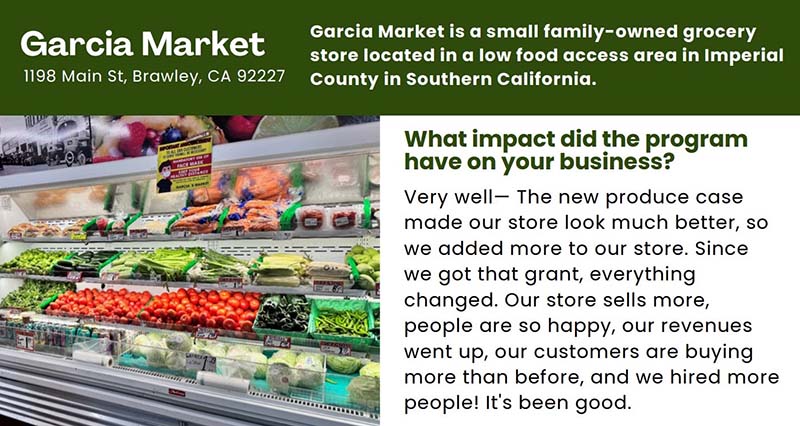The Healthy Refrigeration Grant Program
The Healthy Refrigeration Grant Program (HRGP) funds energy efficient refrigeration units in corner stores, small businesses, and food donation programs in low-income or low-access areas throughout the state to stock California-grown fresh produce, nuts, dairy, meat, eggs, minimally processed, and culturally appropriate foods.
The County of Los Angeles and its partner, The Energy Coalition, received funding in the first round of the Healthy Refrigeration Grant Program to install energy-efficient refrigeration units in small businesses located in food deserts across the county. This video features interviews with some of these store owners about their experiences with the program.
Read CDFA's blog post highlighting the expected emissions savings from Healthy Refrigeration Grant Program’s 2023 Equipment Grants.
Program Status
Mailing List
To sign up for updates or to access your subscriber preferences, please enter your contact information below.
Questions?
Program Impact
Emissions Impact Study
The use of traditional refrigerants in refrigeration equipment has been identified as a significant contributor to greenhouse gas emissions and climate change, accounting for 4% to 5% of greenhouse gas emissions in California today. Refrigeration experts, Effecterra, found that due to the climate-friendly, energy efficient refrigeration units funded by HRGP’s 2023 Equipment Grant, there will be an expected lifetime emission savings of 2,815 tons of carbon dioxide equivalent, which is equal to emissions from 605 homes’ electricity use for one year.
View the full HRGP Emissions Impact Study for additional results on the program’s climate impact.
Pilot Program Evaluation
The Nutrition Policy Institute conducted an evaluation of HRGP’s 2019 Pilot Program and found that storeowners reported that the grant-funded refrigerators decreased their produce waste, increased their ability to sell produce, and allowed them to increase the variety and freshness of the produce they sell. Additionally, 96% of storeowners reported that the program helped them better serve their community.
View the research brief covering an overview of the results from the program evaluation. View the full final report of the HRGP pilot program evaluation findings.
2024 Report to the Legislature
In 2024, CDFA submitted the following report to the legislature with relevant programmatic updates:
2023 Equipment Awards
The California Department of Food and Agriculture Office of Farm to Fork (CDFA-F2F) is excited to announce approximately $9 million in funding for 103 Healthy Refrigeration Grant Program projects across the state.
The purpose of the Healthy Refrigeration Grant Program is to improve access to healthy foods in underserved communities, while promoting California-grown agriculture. The program addresses food insecurity and the lack of accessible fresh fruits and vegetables among low-income Californians through supporting small businesses and food donation programs with refrigeration equipment to expand their selection of California-grown offerings. Additionally, the program encourages grantees to foster relationships with local farmers and ranchers.
These projects represent 43 corner stores and small businesses, 45 food donation programs, and 15 cities, counties, nonprofits, and government organizations providing technical assistance on behalf of an estimated 168 stores.
- View the full list of awarded 2023 projects
- View the 2023 Equipment RFA in English and Spanish
A Geographical Representation of 2023 Awardees
Click on the icons to learn more about each project.
Summary of 2022 Public Comment Period
CDFA-F2F hosted a public comment period from November 21 - December 12, 2022. Stakeholder feedback was used to finalize the RFA and will inform future RFA development.
- View the recording of the listening session in English and Spanish
- View the Summary of Public Comments and CDFA Responses in English and Spanish
-
View the Listening Session presentation slides in
English
and
Spanish
Please note: Due to program delays and California state budget cuts, the dates, timelines, and funding amounts listed in the recordings and slides may be inaccurate.
Technical Assistance Providers
CDFA-F2F held an RFP seeking technical assistance providers to offer outreach, application assistance, and technical expertise to equipment applicants in April 2022, and seven grant awards were announced in July 2022. View a copy of the RFP, Questions and CDFA responses, and a summary of comments and questions submitted and CDFA responses during the public comment period. Grantees include:
- California Green Business Network, a nonprofit that conducted statewide outreach and application assistance as well as worked intensively in several sites, providing hands-on technical expertise
- Community Environmental Council, a nonprofit that conducted outreach and application assistance in low-income and low-food access parts of the south-central coast, in English, Spanish, and Mixtec
- County of San Diego Agriculture, Weights & Measures, a county that conducted outreach and application assistance for area stores in eight languages, leveraging food security work and familiarity with local small businesses
- Contra Costa Health Services, a county that provided outreach, application assistance and technical expertise for retailers in Bay Point
- Effecterra, a small business that offered statewide refrigeration expertise to applicants and created lasting, informative resources for the program
- High Sierra Energy Foundation, a nonprofit that offered outreach and application assistance as well as technical expertise in 14-16 rural, hard to reach counties
- Porchlight Community Services, a nonprofit that conducted outreach and application assistance targeting food donation programs in the San Diego region
2019 Pilot Program
Approximately $4.5 million in grants was awarded during the pilot program. See Round I Grant Awards and Round II Grant Awards for details.
Healthy Refrigeration Resources
The use of traditional refrigerants in refrigeration equipment has been identified as a significant contributor to greenhouse gas emissions and climate change. This program promotes the use of climate-friendly and energy efficient refrigeration equipment and requires the use of refrigerants with a low global warming potential (GWP), a value indicating the amount of global warming a substance may cause.
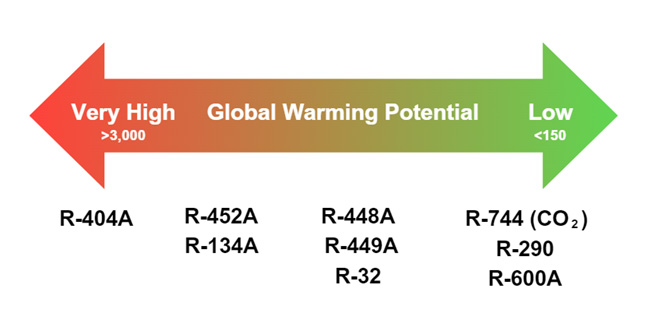
Refrigerants with a high GWP are the most used class of refrigerants and cause significant damage to the climate. The leakage of one 30lb tank of R-404A, a high GWP refrigerant, is equivalent to the CO2 emitted by driving 14 additional passenger cars each year. Refrigeration systems can hold thousands of pounds of refrigerants and leak at the rate of 20% or more per year. Moving away from high GWP refrigerants will slow the pace of global warming and climate impacts currently underway.

Resources
- View Appendix A and Appendix B, which provide pre-vetted low-GWP equipment lists.
- View the Retail Refrigeration Guide which walks you through common issues and maintenance schedules for refrigeration equipment. It also includes best practices for temperature monitoring, refrigerant regulations, and additional resources.
- View the Equipment Maintenance Schedule, a printable checklist designed to help you easily reference the preventative maintenance tasks for refrigeration equipment that should be completed regularly, monthly, and biannually.
- View NASRC Contractor Directory (NASRC Contractor Directory in English / NASRC Contractor Directory in Spanish) for a partial list of contractors who could provide turnkey solutions for purchasing, installation, and recycling equipment
Quick Tips
Energy saving tips:
- Select refrigerated cases with doors to save energy, but if an open unit is necessary (such as for lack of sliding door options and lack of space for hinged doors), use energy saving solutions such as night curtains.
- If you are replacing your current refrigeration system/unit with a new system/unit, ensure that the system/unit is properly decommissioned (i.e., no pipes are cut before being pumped down by a technician) and the refrigerant gas is properly recovered and sent for reclamation, recycling, or destruction to ensure that refrigerant gas emissions are not released, which are extremely harmful to the environment.
Tips for selecting a refrigeration system/unit:
- Past grantees recommend choosing a refrigeration unit with bright lighting to draw customers to it (should use LED lights).
- Think of the products you want to stock in the new refrigerated cases and keep their measurements in mind when selecting a unit to ensure the shelves are long/deep enough to fit the products.
- Refrigerated cases with doors are easier for customers to open compared to sliding doors but require an appropriate amount of space for people to pass with the door(s) open.
- Consider the use of a Temperature Monitoring system to be to your refrigeration unit. These systems monitor temperatures at all times and deliver an uninterrupted measurement, automatically logging record data that can be used for food safety reporting and compliance, as well as generate instant alerts if temperatures rise above a given safety threshold.
Tips for refrigeration installation process:
- Determine and plan in advance whether building doors will need to be removed in order to move new equipment in, and ramps and/or specialist equipment may be needed to navigate uneven ground, curbs, doorways, or changes in level or steps and stairs.
- Find out whether unloading and installing new equipment in its place is part of the purchase — and try to use a turnkey solution that includes everything part of the process including recycling the old refrigerator and disposing of the old refrigerant properly.
Suggestions of where to place refrigeration system/unit:
- Place the refrigerated display case next to the cash registers so customers can make last minute purchases while checking out.
- Creating a produce section by placing refrigerated produce next to unrefrigerated produce has helped some stores to feel more like a market rather than a convenience store.
- Place the refrigerated case where customers can not miss it, such as towards the front of their store so it is the first thing customers see when they walk in.
- Decide where to install your refrigerated case based on usual customer foot traffic as well as increasing their access to the refrigerator.
Tips to sell more fruits and vegetables:
- Have the produce displayed nicely in the refrigerated case — for example, place produce in baskets and/or organize it by type of fruit/vegetable.
- Stock one type of fruit/vegetable per refrigerated shelf so it’s easier for customers to find what they’re looking for.
- Stocking grab-and-go foods like bananas, apples, pre-made salads, and pre-cut veggies encourages customers to buy produce vs purchasing snacks such as candy and chips.
- The most important characteristics past grantees said their customers look for when purchasing fruits and vegetables are freshness, quality, and affordability.
- Many past grantees said customers appreciated the fact they could help support local farmers by purchasing California-grown produce at their store.
Past grantees recommendations for stocking the refrigerated cases:
- Place fruits and vegetables in the refrigerated display case based on what would go bad the fastest to avoid waste and spoilage.
- Stock items that are in season because they may be cheaper to buy and taste fresher.
- Stock produce that is culturally relevant to the dishes your customers cook.
- When starting out, only stock a small quantity of produce because you can buy more produce as needed rather than stocking too much that doesn’t sell.
- Identify whether the produce you’re buying is California-grown by looking at a sticker or label directly on the item or on the box it’s sent in or by talking directly to your vendor.
Other recommendations from past grantees:
- Create simple shelf tags, posters, and other marketing materials to promote new items and store changes to your customers.
- Teach your customers how to cook with different fruits and vegetables sold in your store and share recipes for the items customers are purchasing.
- Work with other healthy retail initiatives in your area to get assistance updating your store to better display produce and improve the overall atmosphere for customers.
View the full Quick Tips document (English / Spanish) on equipment selection, installation, and use for more helpful refrigeration and healthy retail tips
Refrigeration Recycling
Refrigeration appliances may contain materials that can be harmful to human health and the environment if they are not properly removed and recycled. California law requires that major appliances such as refrigeration units and their refrigerants be properly removed and managed.
The basic requirements of proper appliance recycling include the following:
- Materials that Require Special Handling (MRSH) must be removed prior to processing (including crushing and bailing) major appliances for scrap metal (PRC § 42175.1; HSC § 25212)
- A person who intends to remove MRSH must obtain certification from the Department of Toxic Substance Control (DTSC) (HSC § 25211.1)
- Certain documentation must accompany discarded appliances to ensure that MRSH are removed by a Certified Appliance Recycler (CAR) (HSC § 25211.3)
View DTSC's Certified Appliance Recycler (CAR) program website
View DTSC’s list of approved Certified Appliance Recyclers by city.
Additional Funding Opportunities
-
Food Access and Retail Expansion Fund (FARE Fund) is a new program under America’s expanded Healthy Food Financing Initiative (HFFI). The program aims to increase access to healthy foods in communities underserved by grocery stores and ensures that everyone has access to affordable foods while also supporting local farmers and ranchers. Over the next 5 years, the new program will provide $60 million in loans, grants, and technical assistance for the predevelopment, planning, and implementation of eligible food retail and food retail supply chain projects including refrigeration equipment. Potential projects can check for eligibility and sign up to be notified when the program begins accepting applications.
- Eligible projects must plan to expand or preserve the availability of staple and perishable foods in underserved areas with low and moderate-income populations, and if the project involves retail sales, accept benefits under the Supplemental Nutrition Assistance Program (SNAP).
- Rural Energy for America Program (REAP) provides guaranteed loan financing and grant funding to agricultural producers and rural small businesses for renewable energy systems or to make energy efficiency improvements. This USDA program aims to help lower the cost of energy costs for small businesses and agricultural producers by increasing the private-sector supply of renewable energy, and by decreasing the demand for energy through energy efficiency improvements. Funds can be used for cooling and refrigeration units, as well as many other renewable energy systems. Rural small businesses and agricultural producers in California can check their eligibility and learn how to apply.
- The Bay Area Regional Energy Network (BayREN) implements energy savings programs on a regional level in collaboration with the nine Bay Area counties. They offer rebates, funding, and technical assistance to help residents, property owners, business owners and local governments improve the resource-efficiency and carbon footprint of their buildings. BayREN Business offers incentives to local small businesses for energy upgrade projects including energy efficient HVAC, refrigeration, LED lighting, water heating, and more. Small business owners located in the Bay Area can check for eligibility and learn how to apply.
-
PG&E's Energy Efficiency Financing (EEF) offers 0% interest loans to businesses for replacing old and worn-out equipment with more energy-efficient models. Financing is available for many types of projects including to purchase and install new energy-efficient refrigeration equipment. The minimum project loan is $5,000 and monthly payment amounts are based on the customer’s estimated monthly energy savings from the retrofit project. Potential projects can learn more about the program and how to apply.
- Eligible businesses must have at least 24 months of continuous PG&E service with a good standing 12-month payment history.
-
GoGreen Business Energy Financing is administered by the State of California and provides financing with low interest rates to small businesses to fund energy efficiency projects and equipment. Loans up to $5 million are available to owners or lessees of business properties that receive electric and/or gas service from PG&E. The program finances many equipment upgrades including the cost to purchase and install new energy-efficient refrigeration equipment. Small business owners can learn more about the program and how to apply.
- Eligible businesses must meet the program’s established requirements to determine their status as a 'small business.'
- This state-administered program can be paired with any rebate or incentive program including PG&E's Energy Efficiency Financing program (more information is listed above).
-
The F-gas Reduction Incentive Program (FRIP) is administered by the California Air Resources Board and provides $65 million in grant funding to reduce barriers to adopting climate-friendly refrigerant technologies and to reduce emissions of hydrofluorocarbons, which are potent greenhouse gases. Funding is allocated on a first-come, first-served basis. The first application window closes on January 31, 2025, and the second application window opens March 3, 2025, through May 30, 2025. Potential projects can check for eligibility and learn how to apply.
- Eligible applicants include existing facilities with commercial or industrial refrigeration with >50 pounds of high-global warming potential refrigerants in at least one refrigeration system.
- The W.M. Keck Foundation's Southern California Program funds projects that address community health in Los Angeles County. They provide grants to organizations that strengthen under–resourced communities and prioritize those focusing on children and youth. Funds can be used for construction, renovation, and equipment for organizations that meet the goals of the program. Organizations located in Los Angeles County can check their eligibility and learn how to apply.
- The Harden Foundation funds projects for non-profit organizations in Monterey County that focus on health and community services, agricultural and environmental education, and arts and culture. The foundation considers proposals for one–time capital grants, special projects, and operating support. Organizations serving Monterey County can check their eligibility and learn how to apply.
-
The USDA's Community Facilities Direct Loan and Grant Program provides funding to develop essential community facilities in rural areas with a priority of supporting low-income communities. Funds can be used to purchase, construct, and improve essential community facilities, purchase equipment, and pay related project expenses. Funding is available in the form of grants, low interest direct loans, or a combination of the two. Potential projects serving rural areas can check their eligibility and learn how to apply.
- Eligible borrowers include public bodies, community-based non-profits, and federally recognized Tribes.
Grantee Spotlights
Current Projects
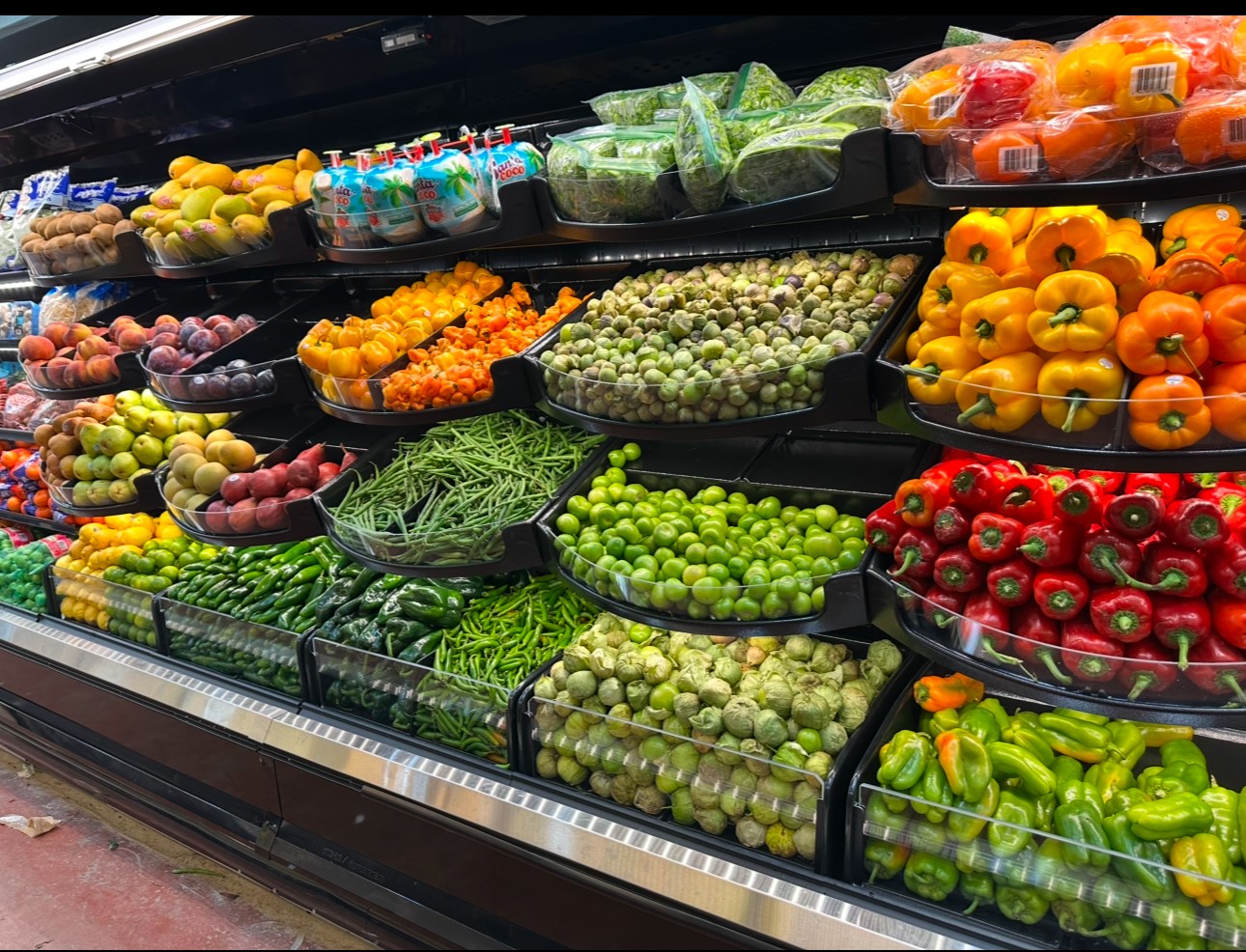
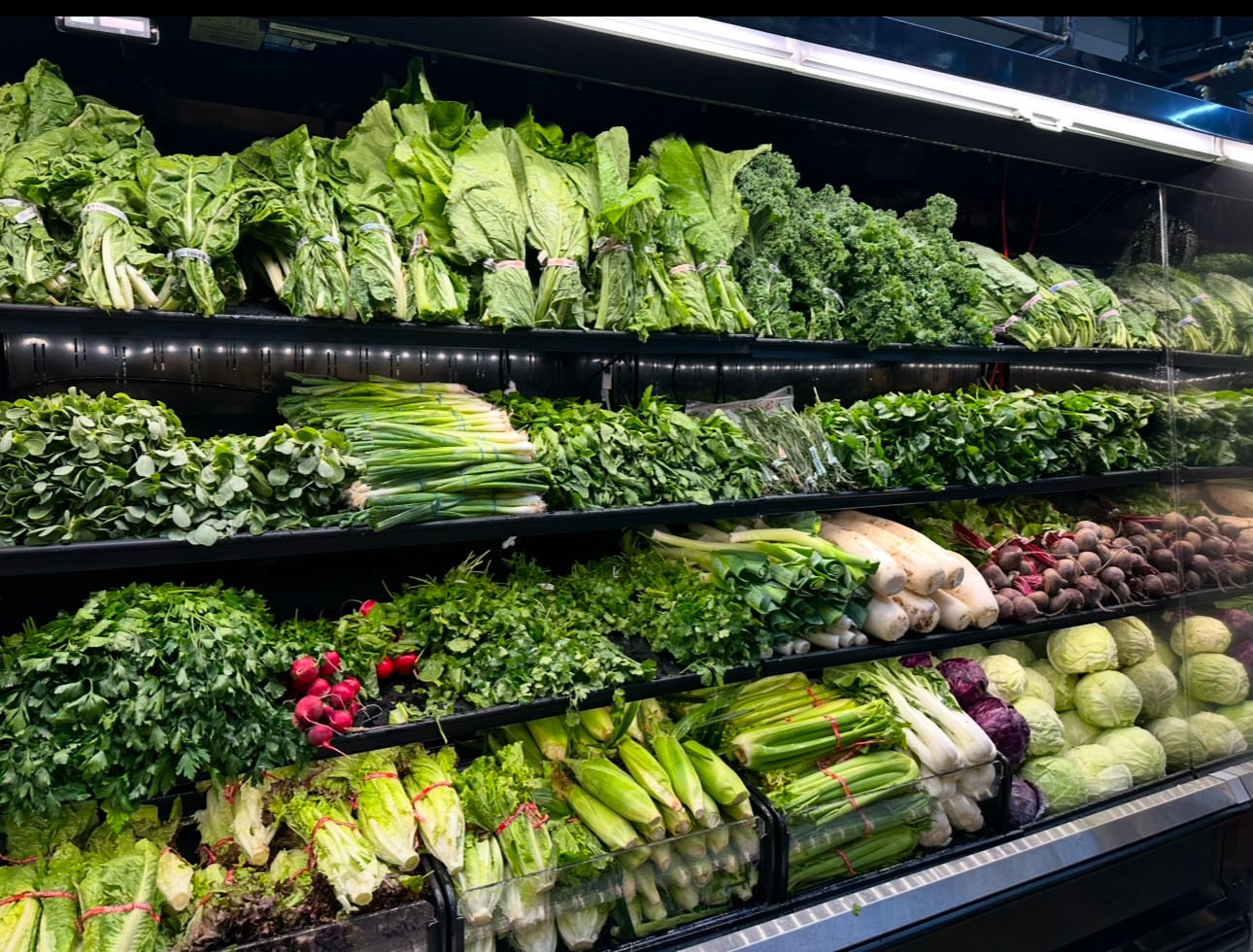
Rancho Market, a corner store in Alameda County, stocked their new equipment with fresh foods that are California-grown and produced. They reported, "The new units provide better temperature control, ensuring that our produce, dairy, and meat stay fresher for longer. This has enhanced the shopping experience for our customers and allowed us to expand our selection of fresh food, making healthier options more accessible to our community."
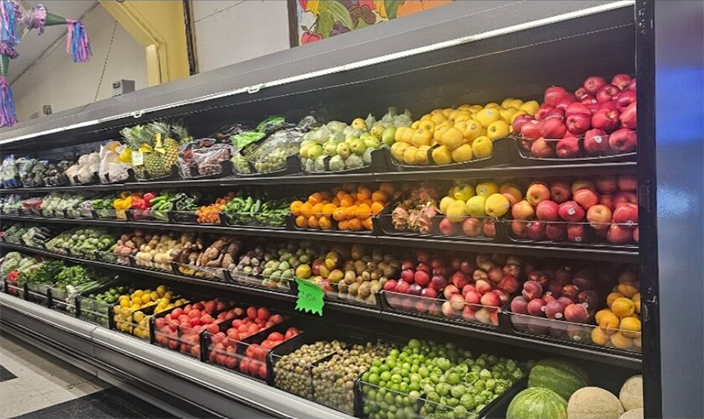
Farmers Market, a corner store in San Pablo, has installed and filled their new refrigerator with a variety of fresh fruits and vegetables. They prioritize stocking products sourced from local farmers and farmers’ markets so their store can support California agriculture while providing their customers with access to fresh, local foods.
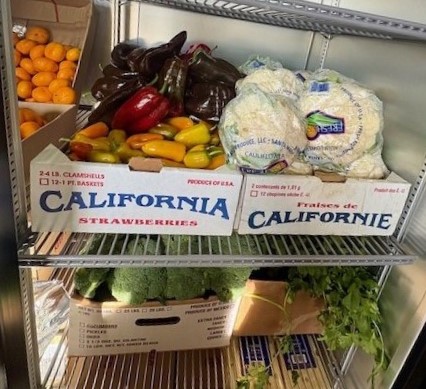
Carpinteria Children’s Project, a community pantry in Santa Barbara County, is beginning to fill their new refrigerator with produce contributed by local California growers. They serve 80-100 families with their monthly food distributions. A staff member reported, “I am thankful to the CDFA Farm to Fork office for providing us with funds to purchase a new refrigerator. We can now confidently fill it with fresh produce for our families in need without worrying that it will break down and the food will go bad.”
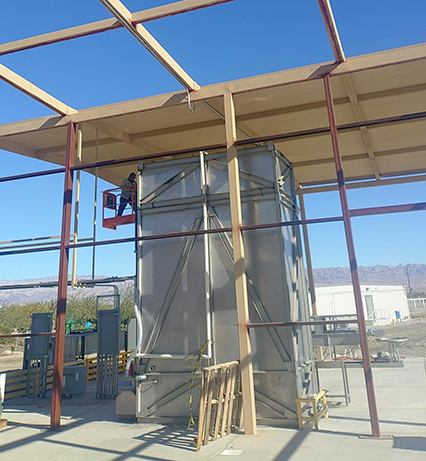
Temalpakh Farm, a rural farm located on a tribal reservation, is owned and operated by the Augustine Band of Cahuilla Indians. With grant funding, they are adding refrigeration to their brick-and-mortar farmers’ market. The tribe recently finished installing the structure of their new walk-in cooler which will be used to store and expand the selection of produce grown on their farm.
Past grantees have said...
Really take the program seriously into consideration. Not only does it help your business but it helps other people to have access to better quality food.
To get a free refrigerator, especially when we’re going through these struggling times, and to get something that helps us to boost our sales is amazing.
The most rewarding aspect of participating in the Healthy Refrigeration Grant Program has been witnessing the direct impact on our community. With the improved refrigeration, we can offer a consistent supply of fresh, healthy food to those who need it most. It has been incredibly fulfilling to see the smiles on the faces of families who now have access to high-quality food and to know that we are contributing to food security and health in our community.
Before receiving this grant, our food pantry relied on an aging refrigerator that frequently malfunctioned, leading to food spoilage and limiting our ability to provide fresh food to the community. With the new energy-efficient refrigerator, we have significantly improved our food storage capacity and reliability. The larger size allows us to store and distribute more fresh fruits, vegetables, dairy, and other perishable items, ensuring that our clients have consistent access to nutritious food.
The new refrigeration display equipment has correlated with a 40 percent increase in fresh produce sales compared to the same period last year. The usable shelf life of our product is now extended for our customers, our waste has been reduced, and the professionalism of the refrigeration display is likely to increase customer confidence and repeat foot traffic to the store.

